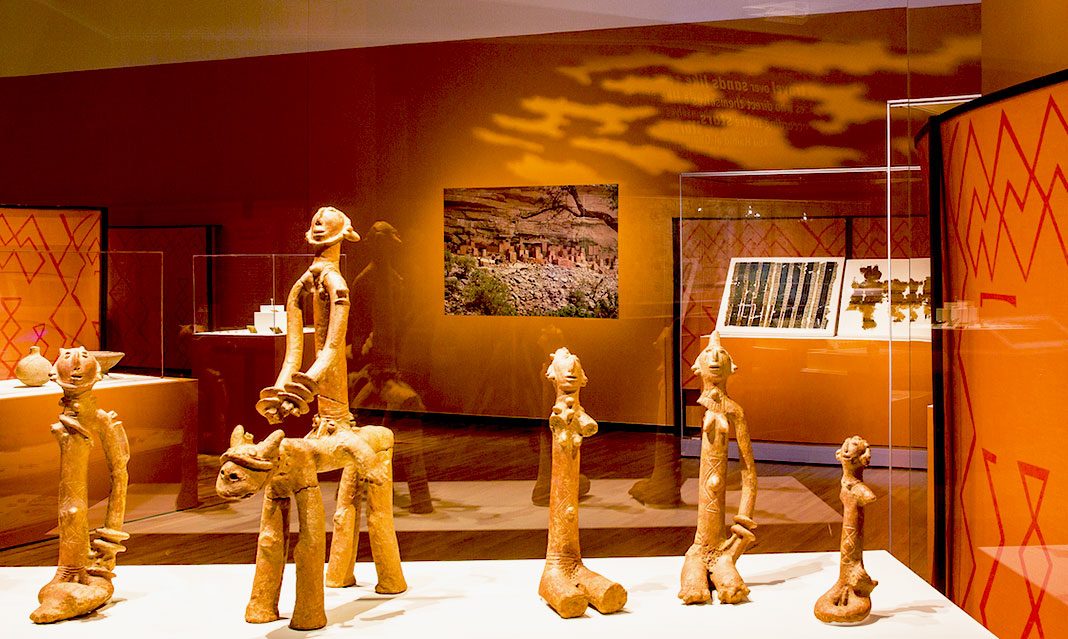Mansa Musa, the King of the Malian Empire in the fourteenth century, made a pilgrimage to Mecca, a journey during which he was accompanied by around “8,000 courtiers, 12,000 slaves, and 100 camels, each carrying up to 300 pounds of pure gold.” He is said, by many historians and scholars, to have been one of the richest person in history. This journey inspires the name of the exhibit, Caravans of Gold: Fragments in Time, currently showing at the AGA Khan Museum, which explores the history of West Africa and the Sahara during the medieval period.
With over 250 objects, the exhibition showcases artifacts, artwork, and various other archeological discoveries from the eighth to the sixteenth century, allowing visitors to see how central the Sahara Desert was to the global network of exchange and trade, and how Islam and Arabic spread to this part of the world. Objects range from gold jewelry and coins, to beautiful sculptures of various materials, to fragments of textiles, to pages from holy and scholarly texts, and many more.
One of the most eye-catching sculptures is the ‘Seated Figure’ from Ife, made of copper, dating back to the late thirteenth and early fourteenth century. Chemical analysis of the raw copper suggests that the material may have originated in France, being brought to Ife where it was displayed in a beautifully intricate and thin cast. The figure was part of the ritual life in Tada, a small village on the banks of the Niger River 120 miles north of Ife in the early twentieth century. During the medieval period, this location would have been strategically important to Ife, connecting it with long distance trade.
Part of the reason this exhibit so aptly fits at the Aga Khan Museum is because it highlights the spread of Islam and contribution of Muslims during this time period.
Towards the beginning of the exhibition, museumgoers will come across the ‘Leaf from the Blue Qur’an,’ one of the most celebrated Quran manuscripts, which originated from either Tunisia or Iraq around the ninth and tenth century. The original manuscript would have contained around 600 folios. These pages are unique because the verses are written in gold leaf, as opposed to shell gold which was the more common technique of making gold manuscripts in the central Islamic world. The manuscript is also decorated with silver over indigo coloured parchment. Indigo, a material used in many other objects at the exhibit, was frequently traded across the Sahara at the time.
The exhibit also includes an installment from a section of a panel from ‘The Catalan Atlas,’ a medieval world map made by Jewish cartographer Abraham Cresques in the fourteenth century in Majorca, Spain. The entire map is made of illuminated parchment mounted on a total of six vertical wooden panels, and was a gift for Charles V, the king of France. This piece includes the portrait of Mansa Musa, with a caption in the Catalan language, describing how this “Moorish ruler” is the “the richest and most distinguished ruler of the whole region on account of the great quantity of gold that is found in his lands.”
The exhibition also displayed various items of everyday or common use, such as the fragments of ‘Tellem’ textiles, found in cave dwellings in Mali, ranging from the eleventh to fourteenth century. Some pieces are fragments of blankets, one is of a cap, and one is of a sleeve. Each piece showcases a high level of technique and various styles of weaving, often dyed with indigo and made of cotton. There are also various displays of gold jewelry and ornaments, one being the ‘Earrings, pendant, and ring,’ thought to have been manufactured in Western Sudan around the thirteenth to fifteenth century, and excavated among the grave goods of a high status person buried at Durbi Takushehyi in north-central Nigeria.
Caravans of Gold is an educational and important experience as it challenges many people’s ideas and misconceptions of the middle ages, as this time period is often taught from a very Eurocentric perspective.
The exhibit, which runs until February 23, allows visitors to see how Africa, in particular West Africa and the Sahara, were incredibly important to the commerce and culture of the world during the medieval period.



